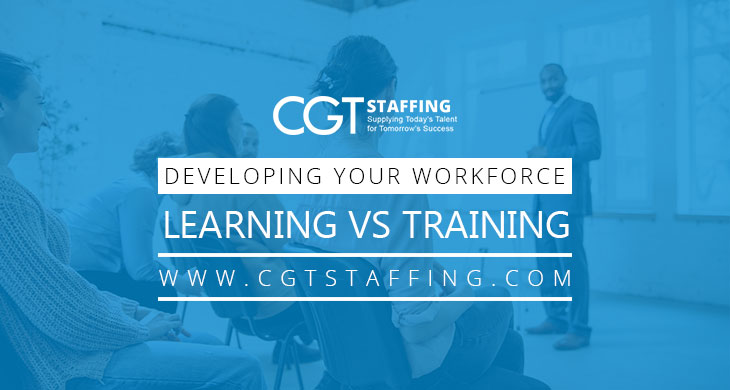In the business world, career progress is significant motivation for most employees. Workers put in significant academic and professional efforts to attain their career and personal goals. Professional experience contributes significantly to how a worker or workforce develops skills and competency over time.
Businesses strategize and enact complex talent acquisition plans to secure the best talent for their teams, but without access to learning or training opportunities, talent is in danger of stagnating.
At first glance, learning and training might seem like interchangeable terms; both have to do with sharing knowledge. However, they are very different means to the end goal of offering valuable and actionable knowledge to a worker. For employers, understanding this difference can be very insightful when choosing workforce development techniques. This blog will briefly cover the differences between the two:
Table of Contents
Understanding Professional Learning
Professional learning is fairly different from its academic counterpart, but the concept is still the same. Participants are provided learning material that they must absorb and understand. This is intended to help them to identify and retain key information, skills, and even complex new concepts. In many cases, business learning is far more visibly impactful in its immediacy.
Attributes of Learning Programs
A solid learning program will typically:
- Offer new skills and/or knowledge.
- Teach the ability to apply skills/knowledge.
- Require proactivity from participants.
- Be a continuous long-term process.
- Deliver sustainable results.
- Offer valuable career development.
- Focus on individual learning.
- Follow a conceptual learning approach.
- Be either formal or informal.
The Mutual Benefit of Learning Programs
Offering learning opportunities can be of mutual benefit to both employers and to employees. Employees learn new skills and ideas that can prepare them for addressing new challenges or unexpected disruptions, thus adding to their professional competence and achievements.
On the other hand, employers that offer learning programs can benefit from a workforce with skilled and knowledgeable employees equipped to take on any business situation. For example, a standardized learning program can quickly and seamlessly integrate a new worker hired from a temp agency in Pittsburgh.
Why Employers Cannot Ignore Learning Needs
Workplace and professional learning are a matter of survival for both workers and employers. Workforces can become stagnant in terms of skill depth, limiting a firm’s ability to navigate disruptive situations. Unless a firm is working closely with an established staffing agency, the probability to acquire talent with all the necessary skills is inherently low.
Learning programs, however, can help workers acquire key new skills and diversify their skill depth to higher levels. Given how quickly market and consumer behavior can change, businesses cannot afford to be complacent. A workforce with the right skills can help businesses adapt and be more agile. Conversely, a workforce with dangerous skill gaps could bring business continuity into question.
Understanding Professional Training
Professional training is chiefly concerned with teaching new and usable skills. However, training is often far more specific and targeted than a learning program. Training programs are designed around specific skills or specific roles, whereas learning programs are more generalized in terms of professional knowledge. For example, a Colorado staffing agency could offer specific training around labor laws and regulations specific to recruitment roles in Colorado.
Components of Training Programs
Training programs in the business world are more focused on teaching than learning. Unlike learning programs, they are very specific in terms of a program’s intended objective. A training program can be:
- Concerned with specific knowledge/skills.
- Structured to ensure better knowledge transmission.
- Indifferent to active engagement or participation.
- Consistent and applicable to batches of similar trainees.
- Linear in terms of learning progress.
- Helpful in developing new skills and competence.
- Testing is usually used as an indication of success.
The Benefits of a Strong Training Program
Training is a knowledge-sharing format frequently tailored to larger groups of workers, and not individuals. Therefore, training programs can accommodate and impact a larger segment of the workforce than a learning program.
The ability to impart crucial new skills and knowledge to multiple workers at the same time can help boost productivity levels across the board. This can help businesses boost employee efficiency and output, thereby supplementing business growth.
Why Employers Cannot Ignore Professional Training
The benefits of a well-trained workforce are fairly obvious. Employees acquire new skills, update their knowledge, and learn to apply them to very specific roles. This increases both productivity and efficiency for a much larger portion of the workforce simultaneously. On the other hand, employers benefit from the enriched workforce and the increased output.
The overall benefit to both parties is considerable, with employees diversifying their skillsets and employers deriving more output from the new skills. Many programs can also be based on replacing older techniques or approaches.
Other training types can involve new safety rules or processes. For example, many manufacturing staffing agencies may only source candidates that possess safety training certifications of newer and safer manufacturing processes.
Conclusion
Both training and learning programs are valid and important approaches in terms of professional workforce development. They are not exclusive to each other – both have the same goal of enriching professional talent and imparting valuable knowledge and skill.
With that in mind, workers can attend both training and learning programs based on what their employer offers and what their role demands. The right mix of training and learning can help businesses become lean, agile, and adaptable. Such curricula can also help create valuable professional skills that benefit workers down the road.
